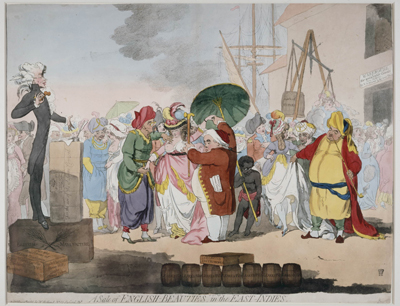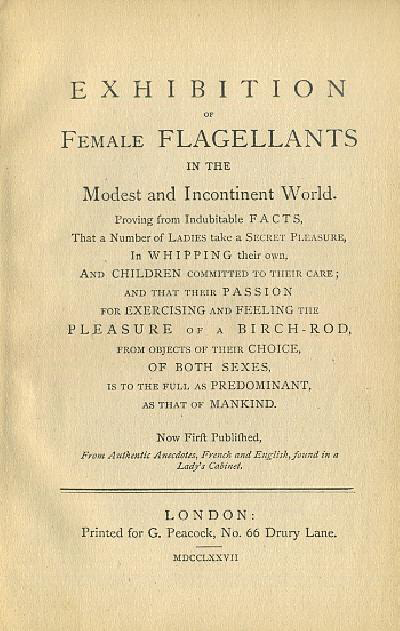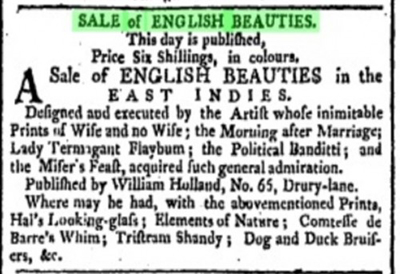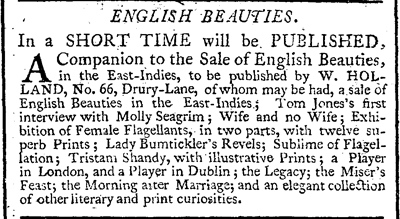A Sale of English Beauties in the East-Indies
This wonderful print satirizes the market for sex in India, portraying it as if it were just another lively port-side market where goods are weighed and inspected by would-be buyers, sold at auction to the highest bidder, or returned to their sellers if deemed to be "unsaleable." Presiding over the market, an auctioneer, who looks more like a French dandy than a representative of Christies, stands before a temporary podium upon a makeshift dais. Would-be customers perform hands-on inspection of the goods for sale. On the far right a woman is weighed against a cask containing 100,000 (equivalent to one lakh) rupees. The podium, dais, boxes, casks, and other objects seen in the print are all connected with sex in one way or another.

© Trustees of the British Museum
The dais, for instance, is a box of birch rods of "British Manufacture" designed for sexual flagellation. Another box, being used as a podium, is labelled from Mrs. Phillips in Leicester Square. According to Lucy Inglis in her blog, Georgian London, Teresia Constantia Phillips was the owner of a well known sex shop called "the Green Cannister." Though it undoubtedly sold a variety of sex toys, the Green Cannister was best known for its condoms—stitched, sealed, and tested. Whatever the contents—whether condoms, dildos, or other sexual devices— the label on the side of the box not only explains its origin but also indicates its intended recipients, the five member Supreme Council of Bengal, the highest excecutive authority within the English East India Company. The fat Englishman in the center of the print may in fact be intended as a representative of the Council, since he carries in his pocket "Instructions for the Governor-General," the head of the Supreme Council.

Published by George Peacock [1777]
© Antique Books
The other box at the feet of the auctioneer is labelled "For the Amusement of Military Gentlemen," of which there were a growing number as the English East India Company evolved from the trade of goods to ruling large swaths of India. The box includes allusions to a variety of libertine French, and erotic English, literature including Voltaire's La Pucelle d'Orleans, Crebillon's Le Sopha: Conte Moral, the best-selling Fanny Hill, and the now more obscure and kinky works, Exhibition of Female Flagellants and Madame Birchini's Dance. In the foreground of the print we see barrels of "Leake's Pills," a supposed remedy for venereal disaese, and, in case of other accidents, a box of "Surgeon's Instruments." On the far right above the warehouse door, there are more barrels—this time Hunter's Restorative, the Viagra of the 18th century. It was advertised in contemporary papers such as the Morning Chronicle and London Advertiser (January 10, 1786), for instance, as
A most valuable Medicine for obstinate Gleetings, Seminal Weaknesses, involuntary Emissions, Impotency, Barrenness, Consumptions, and all Decays of Nature.
A Sale of English Beauties in the East-Indies is one of the works, produced while Gillray was trying to make a name for himself as a skilled etcher/engraver, creating "serious" prints such as The Duke of Athol East Indiaman and Col. Gardiner's Last Interview with his Wife and Daughter as well as satiric prints such as A New Way to Pay the National Debt and The Political Banditti Assailing the Saviour of India. It combines the range of expression, the complex disposition of figures, and the artistic finish of his serious prints together with the satiric thrust of his caricature work. And it was produced in a format (approximately 17 x 21 inches) that was more often associated with serious, artistic prints than satiric caricatures.
And, of course, it was topical. The same May 13th issue of The Morning Post and Daily Advertiser which promoted Gillray's A Sale of English Beauties. . . also included ads for an historical account of India to the present day, TRANSACTIONS IN INDIA, and what was advertised asA GENUINE COPY of the DEFENSE OF WARREN HASTINGS ESQ, the former governor-general of Bengal. As the Hastings trial was getting underway, the culture and corruption of India was at the top of everyone's mind.
But the particular kind of corruption portrayed here was no doubt influenced by his publisher, William Holland, with whom Gillray had been working regularly for the last six months. Holland was well aware that sex and scandal were always profitable enterprises and he was never shy about exploiting them. In fact, he shared a business address (66 Drury Lane) with the same George Peacock that published the erotic and flagellatory volumes mentioned in Gillray's print. So it should come as no surprise that most of the prints that Gillray created for Holland were either sexual in nature, scandalous, or both. They included Gillray's two daring reflections on the Prince of Wales secret marriage to Mrs. Fitzherbert—Wife & No Wife, or a Trip to the Continent, The Morning After Marriage, or A Scene on the Continent, and two prints about the scandalous (and mostly false) rumors surrounding Lady Strathmore and her thoroughly abusive husband: The Injured Count S and Lady Termagant Flaybum Going to Give her Step Son a Taste of her Desert after Dinner. . .
In A Sale of English Beauties, Gillray implies that the trade in sex is both known and allowed at the highest levels of the East India Company, and by the introduction of the slave boy among the crowd, he may also be suggesting its parallel to the slave trade. But unlike the slave trade, the women in A Sale of English Beauties seem to be willing participants. The hands of three of the women (presumably courtesans) are strategically placed in positions where they can do their own sampling of goods. The only distress in the print seems to be coming from the women on the right who are returning to Europe on the next ship as "unsaleable goods."

Unknown Newspaper (May 13, 1786?)
© Princeton University
A NOTE ON THE PUBLICATION DATE & LOCATION
As you can see from the ad for A Sale of English Beauties shown above, the print was first published
from Holland's shop at 66 Drury Lane, the shop that he shared with George Peacock. And even as late
as May 2, 1787, advertisements still list Holland's shop at Drury Lane.

London World Fashionable Advertiser (May 2, 1787)
This suggests that the British Museum copy of the print, though dated in 1786, was most likely produced some time after May of 1787 when Holland had moved to his new location at 50 Oxford Street. It also suggests the enduring popularity of the print, a popularity so great that a companion was obviously planned, but so far as I know, never produced. Later, of course, probably after 1810, Gillray's friend, Thomas Rowlandson published his own successful version of the print.
Sources and Reading
- Commentary from the British Museum on A Sale of English Beauties in the East-Indies.
- Draper Hill, Fashionable Contrasts, 1966, #79
- "East India Company," Wikipedia
- "Mrs Phillips's Covent Garden Sex Shop," Georgian London
- "William Holland's Last Bath" The Printshop Window
- John C. Leffel, "'Where Woman, Lovely Woman, for Wealth and Grandeur Comes from Afar': Representations of the Colonial Marriage Market in Gillray, Topham, Starke, and Austen," Transnational England: Home and Abroad, 1780-1860.
- Vic Gatrell, City of Laughter, Sex and Satire in Eighteenth Century London, New York 2006.
- Julie Melby, "Gillray's Sale of English Beauties and Books," Princeton University Graphic Arts Collection
Comments & Corrections
NOTE: Comments and/or corrections are always appreciated. To make that easier, I have included a form below that you can use. I promise never to share any of the info provided without your express permission.